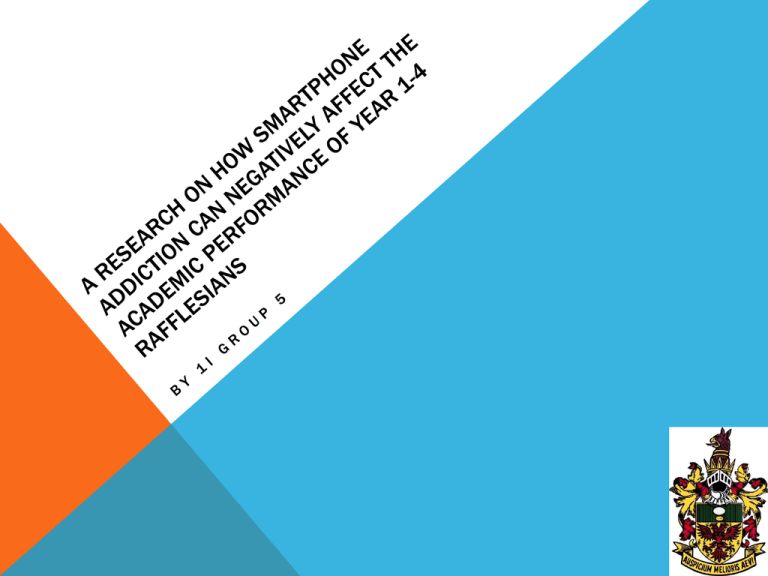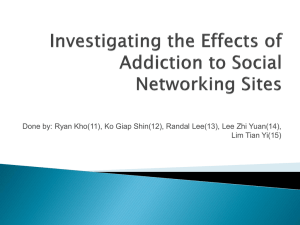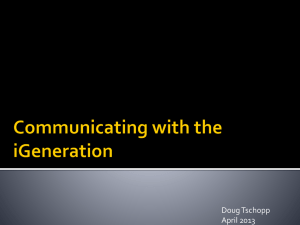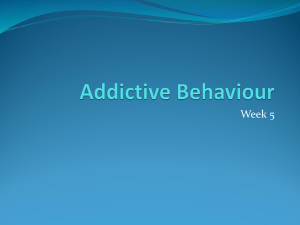A research on how smartphone addiction negatively
advertisement

WHY WE CHOSE THIS TOPIC • Smartphone usage is a popular trend, which also affects many Rafflesians • Aim is to raise awareness of the dangers of smartphone addiction • Consequences of smartphone addiction and the seriousness of its impact. • Will use findings to generate possible effective measure to prevent or curb smartphone addiction SURVEY METHODOLOGY 1/2 HOW THE SURVEY WAS DESIGNED • Not too many questions with quantitative answers: The surveyee may not remember accurately • Designed with indirect questions: The surveyee may be sensitive if questions are too direct • 2 different surveys were created for smartphone and non-smartphone users: So as to compare results with a “control survey”. • To decrease chances of surveyees not responding honestly, the confidentiality of the results was reassured. SURVEY METHODOLOGY 2/2 HOW THE SURVEY WAS CARRIED OUT • Survey distribution was done at canteen after school, where many gather after school. • We wandered around, politely requesting their time to do a survey. • It had to be done on non-CCA days, when more people were available. • To prevent distributing the wrong survey to someone, a question of whether they owned a smartphone had to be asked first. • In order to equalize surveyees from different age-groups, a question about their age had to be asked first. • Other than enquiring about age and smartphone usage, choice of surveyees were totally random PROFILE OF 40 RESPONDENTS BY AGE AND WHETHER THEY ARE SMARTPHONE USERS: Age Group Number of Respondents Percentage of Respondents Smartphone user Number of Respondents Percentage of Respondents Year 1 5 25% Yes 20 50% Year 2 5 25% Year 3 5 25% No 20 50% Year 4 5 25% Total 20 100% Total 40 100% SURVEY FINDINGS 1/3 120% 100% 80% Percentage 60% 40% 20% 0% Year 1 Year 2 Year 3 Year 4 Level Fig. 1: Respondents who observe friends using smartphones frequently SURVEY FINDINGS 2/3 Number of Respondents 5 4 3 2 1 0 Year 1 Year 2 Year 3 Year 4 Level Never 1-2 hours 2-6 hours More than 6 hours Fig. 2: Number of hours spent on their smartphone SURVEY FINDINGS 3/3 70% 60% 50% Percentage 40% Percentage who suffered a decrease academically 30% 20% 10% 0% Year 1 Year 2 Year 3 Year 4 Level SURVEY ANALYSIS • Results show that all of our Year 1, 3 and 4 non-smartphone user surveyees observe friends using smartphones regularly. this implies the massive peer pressure on an individual. • Results show that 60% of year 1 and 4, 40% of year 3 and 20% of year 2 smartphone user surveyees experience a drop in academic performance. This is due to the use of smartphones, because… • Results show that the only surveyees that did not use their smartphone were from year 2, and the only surveyees who spend 6 hours or more on their smartphone a day were from year 4. • There is a connection that can be seen here, those who spend more or less time on their smartphone have their grades decrease or remain the same respectively. INTERVIEW METHODOLOGY 1/2 HOW THE QUESTIONS WERE DESIGNED • The questions were designed to be to the point and not to beat around the bush. • The questions were designed such that the answers would directly help in recognizing, preventing and curbing addiction in students. • Certain questions are designed to make the interviewee draw from personal experience, so the interviewee actually understand the situation of many in Singapore. • In general, the questions are relevant to the subject at hand. INTERVIEW METHODOLOGY 2/2 HOW THE INTERVIEW WAS CARRIED OUT • 3 teachers were emailed a request letter, and their replies were patiently awaited. • After it was decided that their replies would come too late, Sheng Yeow’s father, Si Cheng Choon, was to be interviewed. • On the first attempt, only a third of the interview was recorded due to a device malfuntion, so on the second attempt multiple recorders were used. • As the interview was between father and son, the interview was casual and answers were honest. • Questions were not given to the interviewee beforehand, so as to prevent the socalled “model answer”. INTERVIEW FINDINGS INTERVIEW TRANSCRIPTION: ..\Downloads\RE_INTERVIEWREPORT_TRANSCRIPT.doc INTERVIEW ANALYSIS 1/2 • HOW TO RECOGNIZE ADDICTION • Early teen years are the ages most prone to addiction, as children are more rebellious but may not be mature enough to control themselves. • When a person starts to play at every opportunity. • When a person becomes agitated at well-meant advice. • When a person is oblivious to the outer world while playing. • When a person finds ways around rules • When a person lies or gives sly answers regarding the topic INTERVIEW ANALYSIS 2/2 • HOW TO CURB AND SOLVE THE PROBLEM • Different solutions may work for students with different backgrounds and different causes of addiction. • Students who are bored or lonely at home should be allowed counseling and interaction. • Students who are stubborn and immature should be disciplined. • Worse case-scenario the smartphone has to be confiscated and the student bought a traditional phone, but yet also relinquishing the pros. • Whether the pros and cons outweigh each other or not, depends on the user himself. The methods to stop addiction in someone will generally be in vain if the individual himself does not have the will to stop. CONCLUSION • Our research on the how smartphone addiction enabled us to: • identify the underlying problem. • raise our awareness about the problems. • present some possible solutions. • The survey has helped us to: • get the big picture of addiction in Rafflesians. • Understand individual scenarios rather than just the interviewee’s experience • The interview has helped us to: • find out how to recognize that someone is addicted. • Provide solutions to the problems based on the experience of the interviewee.







